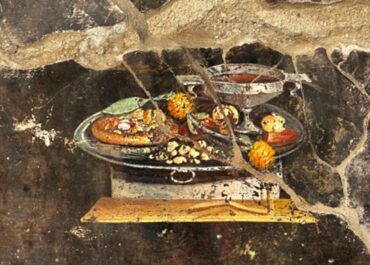
Ancient Pompeii’s culinary delights: beyond the Proto-Pizza
When Pompeii archaeologists unveiled a nearly two-millennium-old fresco resembling what’s now being dubbed a “proto-pizza” last June, it sent shockwaves across the globe. Though it boasted potential toppings like meats, fruits, or veggies, the iconic tomato—a staple in today’s pizzas—was noticeably absent.
This deliciously juicy fruit didn’t grace European soils until the 16th century, centuries after the catastrophic eruption of Mount Vesuvius in 79 A.D., which annihilated the Roman cities of Pompeii and Herculaneum. The pizza we relish today? That’s a Neapolitan masterpiece from the 18th century.
But if Pompeii didn’t pioneer pizza, what culinary delights did its inhabitants indulge in? From umami-packed condiments, lasagna’s precursor, to gourmet stuffed dormice, here’s a culinary journey through ancient Pompeii.
Click here to explore the top guided tours of Pompeii and delve deep into its millennia-old history.
A Culinary time capsule: why Pompeii stands out
Pompeii’s archaeological significance cannot be understated. While Mount Vesuvius’ eruption was a force to be reckoned with, Pompeii wasn’t obliterated by lava but enshrouded in a colossal cloud of searing gas and ash. This phenomenon, as elucidated by Alessandro Russo of the Pompeii Archaeological Park, instantly carbonized and safeguarded a plethora of organic materials, including food.
The swift, unforeseen demise of Pompeii’s citizens has granted archaeologists an unfiltered peek into mundane activities like culinary preparations. The discovery of an impeccably conserved loaf of bread from Herculaneum in 1930—etched with markings for easy separation—is testament to this. According to Russo, such findings make Pompeii an unparalleled archaeological marvel.
Umami: Pompeii’s savory obsession
Perhaps Pompeii’s most cherished ingredient was a precursor to the universally adored umami flavor: garum. A tantalizing fish sauce or seasoning, garum was Pompeii’s answer to contemporary ketchup. Though its flavor profile is more akin to Southeast Asian fish sauces, its omnipresence in Pompeiian cuisine is undeniable.
Distinguished for its caliber, Pompeii’s garum was a fermented concoction of specific fish, like the sea bream, blended with salt and occasional spices over months. As the fish disintegrated, the residue was the coveted garum.
Benedict Lowe, from the University of North Alabama, who was associated with the Pompeii Food and Drink Project, shares that this sauce’s intense aroma remains intact even today.
Pompeii’s gourmet legacy
Carbonized remnants and medieval translations of ancient recipes have unveiled Pompeii’s gastronomic treasures. Chiara Comegna, an archaeobotanist, speaks of a lasagna precursor with meat, ricotta, and pasta layers.
The affluent in Pompeii reveled in exotic dishes like stuffed dormice—a hefty version of modern mice. This delicacy, as per the famed cookbook by Apicius, was infused with pork, pine nuts, pepper, and fish sauce.
While literary records allude to the elite feasting on flamingoes, Lowe recommends approaching such claims with skepticism.
Reenacting the age-old recipes in 2005, researchers even reintroduced fruits and vegetables endemic to Pompeii, including figs, olives, grapes, and plums.
Tastes of the time
Although a majority of Pompeiian food was rather bland, the wealthy indulged in exotic spices, sourced from distant lands like India. In fact, the Romans’ prodigious expenditure on spices even led the Indians to adopt Roman currency for a brief period.
Comegna adds an interesting tidbit: Pompeiians added fava beans to their wine, modifying its hue and flavor.
Dining the Pompeiian way
Pompeii’s thermopolia stalls were the precursor to modern-day fast food. Nearly 80 such outlets dotted the city, catering to the everyday worker. These stalls dispensed an array of edibles—snails, ducks, pigs, goats, and fish—all served in embedded containers.
Evidence suggests that the Pompeiians primarily relied on finger foods, apt for their practice of reclining on dining couches while eating. And while breakfast was virtually non-existent, opulent dinner feasts, especially among the elite, were the norm. In essence, the culinary tapestry of ancient Pompeii is a testament to its vibrant culture, illustrating that there’s so much more to it than just a “proto-pizza.”
